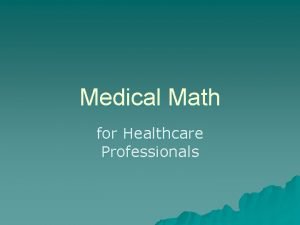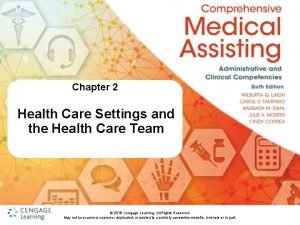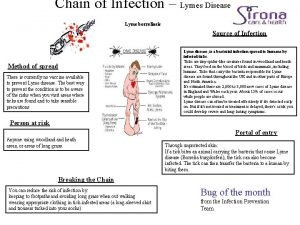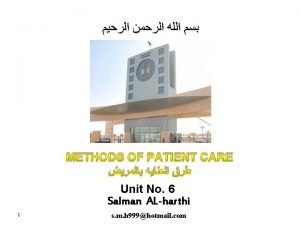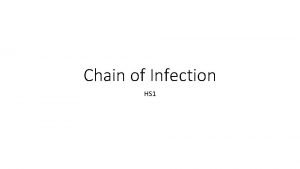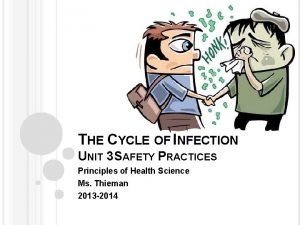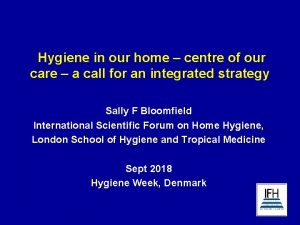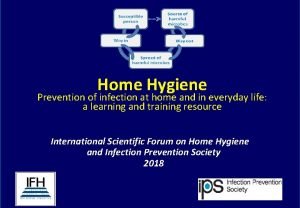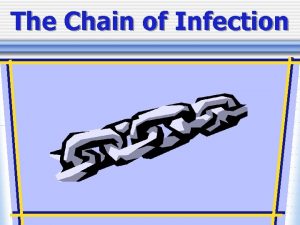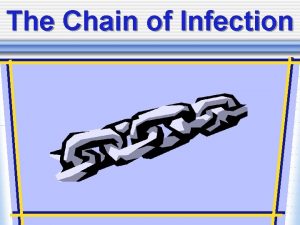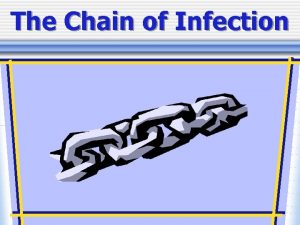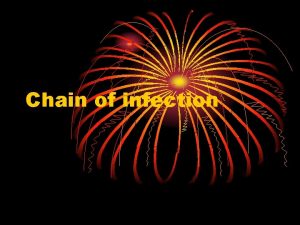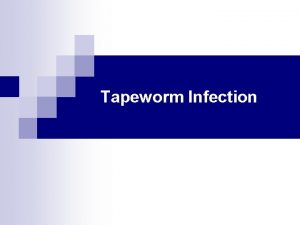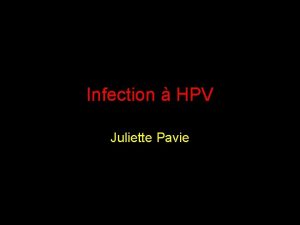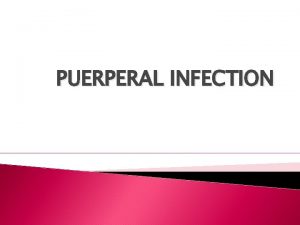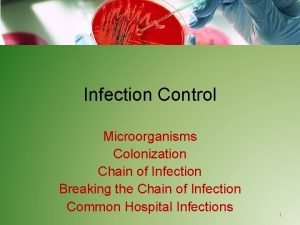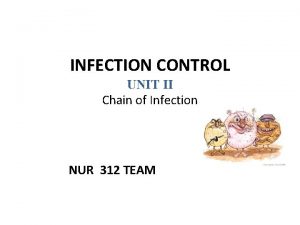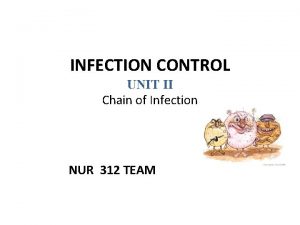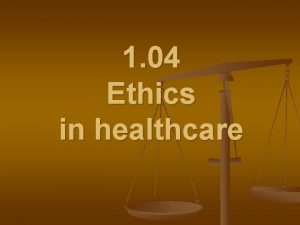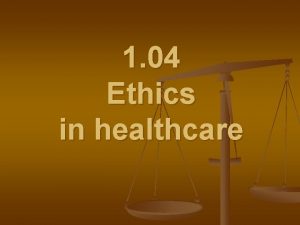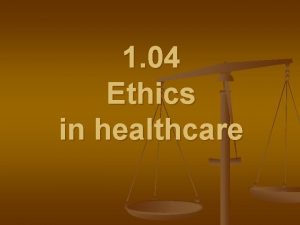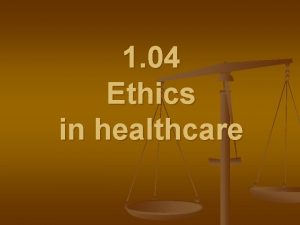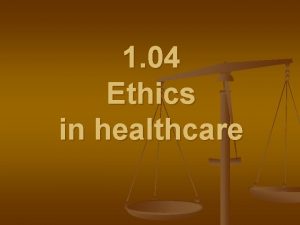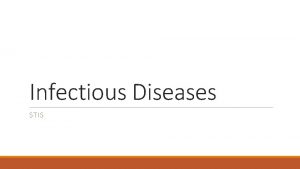The Chain of Infection As healthcare professionals it































- Slides: 31

The Chain of Infection

As healthcare professionals, it is important to understand two things about infection: infection

1. the various ways infection can be transmitted 2. the ways the infection chain can be broken

There are six links in the chain of infection :

1 st - The Infectious Agent -any disease-causing microorganism (pathogen)

Types of Microorganisms • Bacteria- simple one-celled organisms w Cocci (round shape-e. g. . , streptococci) w Bacilli (rod shaped – e. g. , TB) w Spirilla (spiral shape – e. g. , syphilis) • Protozoa – one-celled animals often found in decayed materials & contaminated water (amebic dysentery, malaria) • Fungi - Plant-like organisms that live on dead organic matter (yeasts and molds – e. g. , thrush) • Rickettsiae (parasitic organisms – fleas, ticks, mites – e. g. , Lyme disease) • Viruses - smallest microbes (HIV, Hepatitis B and C) • Helmiths - parasitic worms

2 nd - The Reservoir -the organism/place in which the infectious microbes reside

What are “Carrier Hosts” Hosts that do not show any outward signs or symptoms of a disease but are still capable of transmitting the disease are known as carriers.

3 rd - The Portal of Exit -route of escape of the pathogen from the reservoir. Examples: respiratory secretions, blood exposure, breaks in skin

4 th - The Route of Transmission -method by which the pathogen gets from the reservoir to the new host

Transmission may occur through: direct contact

air

insects

5 th - The Portal of Entry -route through which the pathogen enters its new host

Respiratory System n it o a l a h in

in ge st i on Gastrointestinal System

Se c o xu n t al ac t Urinary & Reproductive Tracts

Breaks in Protective Skin Barrier

6 th - The Susceptible Host -the organism that accepts the pathogen The support of pathogen life & its reproduction depend on the degree of the host’s resistance.

Organisms with strong immune systems are better able to fend off pathogens.

Organisms with weakened immune systems are more vulnerable to the support & reproduction of pathogens.

How to interrupt the chain of infection: -The essential part of patient care & self-protection.

1. Pathogen Identification -identification of infectious agent & appropriate treatment

2. Asepsis & Hygiene -potential hosts & carriers must practice asepsis & maintain proper personal hygiene

3. Control Portals of Exit -healthcare personnel must practice standard precautions:

(Control body secretions & wash hands according to protocol. )

4. Prevent a Route of Transmission -prevent direct or indirect contact by: 1. Proper handwashing 2. Disinfection & sterilization techniques 3. Isolation of infected patients 4. Not working when contagious

5. Protect Portal of Entry -Health professionals must make sure that ports of entry are not subjected to pathogens. (nose, mouth, eyes, urinary tract, open wounds, etc. )

6. Recognition of Susceptible Host -health professionals must recognize & protect high-risk patients

• Cancer Patients • AIDS Patients • Transplant Patients • Infant & Elderly Patients

Remember--breaking the chain of infection is the responsibility of each health professional.
 Chapter 13 medical math
Chapter 13 medical math Healthcare and the healthcare team chapter 2
Healthcare and the healthcare team chapter 2 Healthcare and the healthcare team chapter 2
Healthcare and the healthcare team chapter 2 Eltonian pyramid
Eltonian pyramid Chain of infection for lyme disease
Chain of infection for lyme disease Chain of infection cycle
Chain of infection cycle Portal of entry
Portal of entry Chain of infection
Chain of infection Breaking the chain of infection
Breaking the chain of infection Chain of infection
Chain of infection What is logistics management
What is logistics management Open kinetic chain
Open kinetic chain Trời xanh đây là của chúng ta thể thơ
Trời xanh đây là của chúng ta thể thơ Voi kéo gỗ như thế nào
Voi kéo gỗ như thế nào Số nguyên là gì
Số nguyên là gì Thiếu nhi thế giới liên hoan
Thiếu nhi thế giới liên hoan Tia chieu sa te
Tia chieu sa te Một số thể thơ truyền thống
Một số thể thơ truyền thống Các châu lục và đại dương trên thế giới
Các châu lục và đại dương trên thế giới Thế nào là hệ số cao nhất
Thế nào là hệ số cao nhất Sơ đồ cơ thể người
Sơ đồ cơ thể người Tư thế ngồi viết
Tư thế ngồi viết Hát kết hợp bộ gõ cơ thể
Hát kết hợp bộ gõ cơ thể đặc điểm cơ thể của người tối cổ
đặc điểm cơ thể của người tối cổ Mật thư anh em như thể tay chân
Mật thư anh em như thể tay chân Tư thế worms-breton
Tư thế worms-breton ưu thế lai là gì
ưu thế lai là gì Thẻ vin
Thẻ vin Cái miệng nó xinh thế chỉ nói điều hay thôi
Cái miệng nó xinh thế chỉ nói điều hay thôi Thơ thất ngôn tứ tuyệt đường luật
Thơ thất ngôn tứ tuyệt đường luật Các châu lục và đại dương trên thế giới
Các châu lục và đại dương trên thế giới Từ ngữ thể hiện lòng nhân hậu
Từ ngữ thể hiện lòng nhân hậu
